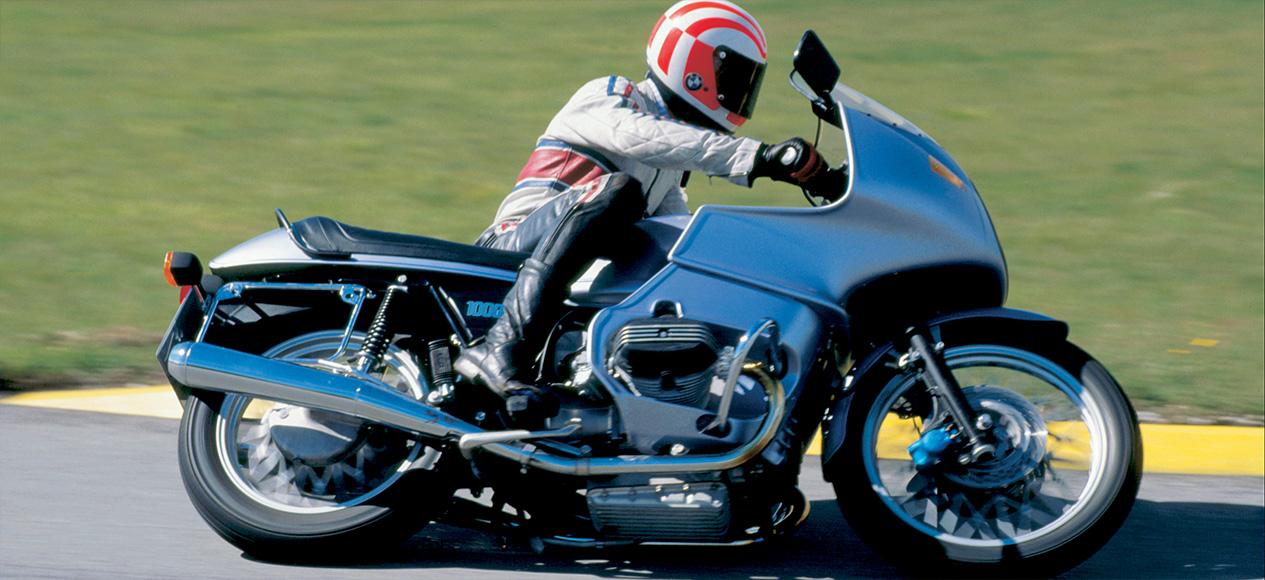Iconic bikes: BMW R100RS
Back in 1976, the thought of a production motorcycle with a full fairing was pretty radical, but that’s just what BMW did when it launched the R100RS.
Fairings were nothing new, of course. Streamlining had been the norm on Grand Prix race bikes for decades and, in late 1966, an American designer called Craig Vetter put his aftermarket fairings for road bikes into production. Following some modern success with his Phantom fairings in the late 1960s, Vetter’s Windjammer designs of the 1970s sold in the hundreds of thousands. BMW had fitted a small handlebar mounted fairing to its R90S in 1973, but the success of Vetter’s designs suggested that there was a demand for an all-encompassing fairing for riders who wanted to rack up big distances in comfort: the R100RS was born.
Against the new generation of multi-cylinder Japanese superbikes arriving on the scene, BMW’s /6 series boxer twins were seen as old fashioned and conservative in their design. The new /7 series, introduced in 1976, was an evolution rather than an revolution but the star of the new range was the new RS model.
The frame mounted full fairing of the R100RS gave BMW a whole new perspective, not just from a design and marketing perspective but from a genuine performance and practicality point of view. It created a new category of motorcycle, the Sports Tourer. Indeed the designation, RS, was short for Reisesport – the German words for ‘travel’ and ‘sport’.
The RS made just 70bhp (up from the 60bhp of the base R100) but the slippery fairing helped it to a 125mph top speed. More significantly, the R100RS’s wind protection offered riders wind protection never before seen on a street bike. Two years later, BMW launched the R100RT, with a more upright riding position, luggage and an even bigger fairing. It would become the staple for police forces around the world for decades to come.

Ultimately, the original R100RS was defined by its fairing more than anything else. Under the skin, the 980cc two-valve twin was old-fashioned technology, and even though the whole thing was brilliantly engineered, it lacked the innovation and technology of the new wave of Japanese machines. The model remained largely unchanged in its eight-year run, with just small upgrades every year or so: 1978 saw cast wheels replaces the original spoked items, with a disc rear brake replacing the original drum, while 1980 saw the adoption of electronic ignition and a new CV carb to improve emissions. As the 1980s saw a host of new technology come into the marketplace (much of it, like ABS, from BMW themselves in the K series models) the R100RS quickly slipped out of fashion.
The ‘airheads’ as the last of the pure air-cooled BMW boxers were known, enjoyed a long production run, with the last R100RTs rolling off the production line in 1996. The RS had an eight year lifespan, with the last bikes coming in 1984, when it was replaced by the new generation K series K100RS. These K series models, known as ‘bricks’ due to the unusual longitudinally mounted powerplant had its cylinder head sticking out the side of the bike, never really caught the attention of the buying public. The 1990s saw the boxer engine reinvented with a new generation of air/oil cooled twins (known to enthusiasts as ‘oilheads’) and while BMW launched the R1100RS, it never enjoyed the same popularity as the GS and RT variants.
As classic bikes go, the BMW R100RS is an affordable and usable option. The RS was expensive when new, but these days between £3-5000 will bag you a decent example. The fact that they tend to attract a certain type of owner (even the modern fairing couldn’t change BMW’s reputation of being the bike of choice for the older gentleman) means that few have been abused, while the good build quality and simplicity of the mechanicals ensure that a high percentage have remained on the road.
We believe that the R100RS deserves its place in our Iconic Bikes series. As the world’s first production bike with a full fairing, it created a whole new genre of motorcycle and will forever hold a place in the history books.




